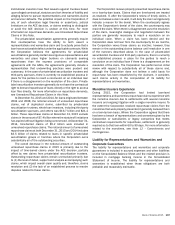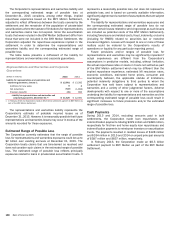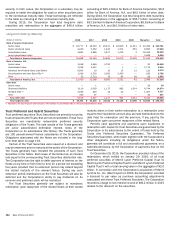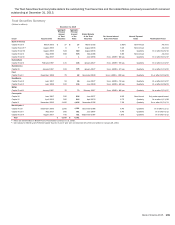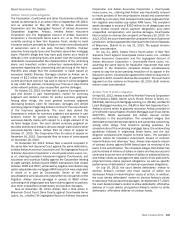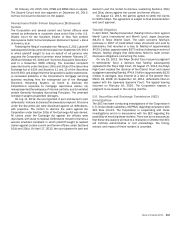Bank of America 2015 Annual Report Download - page 199
Download and view the complete annual report
Please find page 199 of the 2015 Bank of America annual report below. You can navigate through the pages in the report by either clicking on the pages listed below, or by using the keyword search tool below to find specific information within the annual report.Bank of America 2015 197
Other Guarantees
Bank-owned Life Insurance Book Value Protection
The Corporation sells products that offer book value protection to
insurance carriers who offer group life insurance policies to
corporations, primarily banks. The book value protection is
provided on portfolios of intermediate investment-grade fixed-
income securities and is intended to cover any shortfall in the
event that policyholders surrender their policies and market value
is below book value. These guarantees are recorded as derivatives
and carried at fair value in the trading portfolio. At December 31,
2015 and 2014, the notional amount of these guarantees totaled
$13.8 billion and $13.6 billion. At both December 31, 2015 and
2014, the Corporation’s maximum exposure related to these
guarantees totaled $3.1 billion with estimated maturity dates
between 2031 and 2039. The net fair value including the fee
receivable associated with these guarantees was $12 million and
$25 million at December 31, 2015 and 2014, and reflects the
probability of surrender as well as the multiple structural protection
features in the contracts.
Indemnifications
In the ordinary course of business, the Corporation enters into
various agreements that contain indemnifications, such as tax
indemnifications, whereupon payment may become due if certain
external events occur, such as a change in tax law. The
indemnification clauses are often standard contractual terms and
were entered into in the normal course of business based on an
assessment that the risk of loss would be remote. These
agreements typically contain an early termination clause that
permits the Corporation to exit the agreement upon these events.
The maximum potential future payment under indemnification
agreements is difficult to assess for several reasons, including
the occurrence of an external event, the inability to predict future
changes in tax and other laws, the difficulty in determining how
such laws would apply to parties in contracts, the absence of
exposure limits contained in standard contract language and the
timing of the early termination clause. Historically, any payments
made under these guarantees have been de minimis. The
Corporation has assessed the probability of making such
payments in the future as remote.
Merchant Services
In accordance with credit and debit card association rules, the
Corporation sponsors merchant processing servicers that process
credit and debit card transactions on behalf of various merchants.
In connection with these services, a liability may arise in the event
of a billing dispute between the merchant and a cardholder that
is ultimately resolved in the cardholder’s favor. If the merchant
defaults on its obligation to reimburse the cardholder, the
cardholder, through its issuing bank, generally has until six months
after the date of the transaction to present a chargeback to the
merchant processor, which is primarily liable for any losses on
covered transactions. However, if the merchant processor fails to
meet its obligation to reimburse the cardholder for disputed
transactions, then the Corporation, as the sponsor, could be held
liable for the disputed amount. In 2015 and 2014, the sponsored
entities processed and settled $669.0 billion and $647.1 billion
of transactions and recorded losses of $22 million and $16 million.
A significant portion of this activity was processed by a joint venture
in which the Corporation holds a 49 percent ownership. At
December 31, 2015 and 2014, the sponsored merchant
processing servicers held as collateral $181 million and $130
million of merchant escrow deposits which may be used to offset
amounts due from the individual merchants.
The Corporation believes the maximum potential exposure for
chargebacks would not exceed the total amount of merchant
transactions processed through Visa and MasterCard for the last
six months, which represents the claim period for the cardholder,
plus any outstanding delayed-delivery transactions. As of
December 31, 2015 and 2014, the maximum potential exposure
for sponsored transactions totaled $277.1 billion and $269.3
billion. However, the Corporation believes that the maximum
potential exposure is not representative of the actual potential
loss exposure and does not expect to make material payments in
connection with these guarantees.
Exchange and Clearing House Member Guarantees
The Corporation is a member of various securities and derivative
exchanges and clearinghouses, both in the U.S. and other
countries. As a member, the Corporation may be required to pay
a pro-rata share of the losses incurred by some of these
organizations as a result of another member default and under
other loss scenarios. The Corporation’s potential obligations may
be limited to its membership interests in such exchanges and
clearinghouses, to the amount (or multiple) of the Corporation’s
contribution to the guarantee fund or, in limited instances, to the
full pro-rata share of the residual losses after applying the
guarantee fund. The Corporation’s maximum potential exposure
under these membership agreements is difficult to estimate;
however, the potential for the Corporation to be required to make
these payments is remote.
Prime Brokerage and Securities Clearing Services
In connection with its prime brokerage and clearing businesses,
the Corporation performs securities clearance and settlement
services with other brokerage firms and clearinghouses on behalf
of its clients. Under these arrangements, the Corporation stands
ready to meet the obligations of its clients with respect to securities
transactions. The Corporation’s obligations in this respect are
secured by the assets in the clients’ accounts and the accounts
of their customers as well as by any proceeds received from the
transactions cleared and settled by the firm on behalf of clients
or their customers. The Corporation’s maximum potential exposure
under these arrangements is difficult to estimate; however, the
potential for the Corporation to incur material losses pursuant to
these arrangements is remote.


